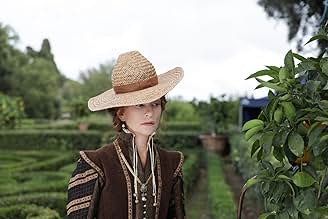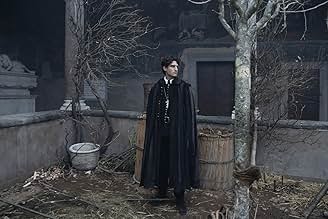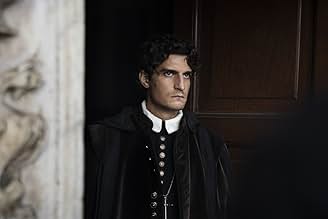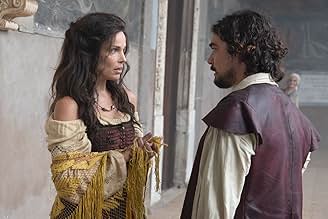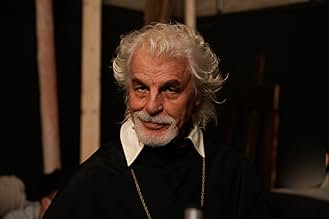NOTE IMDb
6,5/10
1,9 k
MA NOTE
L'Église catholique enquête secrètement sur le Caravage, alors que le pape se demande s'il doit lui accorder la clémence pour avoir tué un rival.L'Église catholique enquête secrètement sur le Caravage, alors que le pape se demande s'il doit lui accorder la clémence pour avoir tué un rival.L'Église catholique enquête secrètement sur le Caravage, alors que le pape se demande s'il doit lui accorder la clémence pour avoir tué un rival.
- Réalisation
- Scénario
- Casting principal
- Récompenses
- 13 victoires et 6 nominations au total
Avis à la une
I just thought that this movie about such big artist would have more art in it. The process and the hard work. Instead, all I got was already finished paintings and an italian telenovela with more dialogue than Nolan's Oppenheimer, with no time to absorb the beauty of the cinematography and the poetic essence of Caravaggio's life and his work.
But I thought using Schatten's perspective of interviewing Caravaggio's models and other people he met and capturing their narratives and stories so the viewer can learn more about the artist was smart and the story came nicely full circle at the end. But that still doesn't compensate the rest for me.
Riccardo Scamarcio has a nice butt tho.
But I thought using Schatten's perspective of interviewing Caravaggio's models and other people he met and capturing their narratives and stories so the viewer can learn more about the artist was smart and the story came nicely full circle at the end. But that still doesn't compensate the rest for me.
Riccardo Scamarcio has a nice butt tho.
Caravaggio's Shadow is a fever dream of a film, vividly photographed and convincingly played by an (unsurprisingly) handsome Italian cast.
There's plenty of melodrama, but it's an Italian period piece; anything less would have felt restrained.
At the heart of it is an irresolvable contradiction: the Vatican and papacy are the immensely rich and powerful core of Catholicism, but Catholicism is anchored by the teachings of Jesus, friend of the poor, the outcast and the desperate. What happens when the Vatican's most talented painter - a devout genius - uses the poor, the disgraced, and the outcasts of society as his subjects in seeking the truth of scripture?
Expect plenty of debauchery, plenty of on-location renaissance architecture, some intrigue, and even some swashbuckling swordfighting.
Worth your time.
There's plenty of melodrama, but it's an Italian period piece; anything less would have felt restrained.
At the heart of it is an irresolvable contradiction: the Vatican and papacy are the immensely rich and powerful core of Catholicism, but Catholicism is anchored by the teachings of Jesus, friend of the poor, the outcast and the desperate. What happens when the Vatican's most talented painter - a devout genius - uses the poor, the disgraced, and the outcasts of society as his subjects in seeking the truth of scripture?
Expect plenty of debauchery, plenty of on-location renaissance architecture, some intrigue, and even some swashbuckling swordfighting.
Worth your time.
A lot is not known about Caravaggio's life, but a lot is. It is understandable and legitimate that a film like this fills in the unknown gaps. The fact that it twists, falsifies and rewrites the known things is unworthy of a biography.
I am anything but a friend of the Catholic Church and even less of the church leaders. But the way he was portrayed here in a one-sided way as a victim of the church, whose representatives were Caravaggio's most zealous supporters, is infamous. "The Death of Mary" has nothing to do with being rejected by a pope; the monks who commissioned it did that themselves. Because Caravaggio did not paint in accordance with the commission. And the painting was not saved by Rubens, who is said to have bought it in Rome according to the film, but by Ferdinando Gonzaga, Duke of Mantua, the year after it was completed. Or the questioning of Artemisia Gentileschi. Caravaggio probably didn't even know her, even if her father did.
And these inaccuracies, distortions and falsifications run through the entire film, which has only one goal: to save the artist's honor. But he doesn't need to be saved. His art speaks for itself, as does his raw, unbridled character, which borders on brutality. Presenting the church as his murderer is an affront to all the church's real victims.
So an honorable attempt becomes a historically useless piece of work that doesn't bring you any closer to the artist's work. His apotheotic classification as a three-eyed man among the blind is tiring early on in the film.
I am anything but a friend of the Catholic Church and even less of the church leaders. But the way he was portrayed here in a one-sided way as a victim of the church, whose representatives were Caravaggio's most zealous supporters, is infamous. "The Death of Mary" has nothing to do with being rejected by a pope; the monks who commissioned it did that themselves. Because Caravaggio did not paint in accordance with the commission. And the painting was not saved by Rubens, who is said to have bought it in Rome according to the film, but by Ferdinando Gonzaga, Duke of Mantua, the year after it was completed. Or the questioning of Artemisia Gentileschi. Caravaggio probably didn't even know her, even if her father did.
And these inaccuracies, distortions and falsifications run through the entire film, which has only one goal: to save the artist's honor. But he doesn't need to be saved. His art speaks for itself, as does his raw, unbridled character, which borders on brutality. Presenting the church as his murderer is an affront to all the church's real victims.
So an honorable attempt becomes a historically useless piece of work that doesn't bring you any closer to the artist's work. His apotheotic classification as a three-eyed man among the blind is tiring early on in the film.
The movie is the story of Michelangelo Merisi da Caravaggio who was an Italian painter in the 16th century, through the eyes of the Pope's investigator. He was known for painting "what he saw", some kind of reality that he wanted close to the divine, which was of course not ok with the Catholic Church. Within his paintings, you could see famous prostitutes, hoboes, represented as saints, such as Mary or St Peter. His life has multiple legends around it, he was known to have sexual relationships with both males and females, while painting for the Church, and his competitors tried to destroy him for that. He had to flee Rome after killing (accidentally?) someone and lived in Naples, Sicily, Malta, etc. The story of the movie is a bit long, but this is not why you should see this movie. The whole movie is staged as a painting, with that kind of atmosphere that you get from 16th century Italian paintings. Would I watch it again? No, but I am happy I watched it.
I saw it as a fair work. For beautiful cinematography, reminding, scene bty scene, the art of Michelangelo Merisi, for Riccardo Scamarcio and his work in skin of Caravaggio, for Isabelle Huppert and Louis Garel, more than inspired crafters of their characters , for music and for good kick to viewer to (re)discover a great artist masterpieces.
Obvious, the film reflects the perspective of Michele Placcido and, I admitt, far to be easy say about the best manner to reflect a life defined by torments, force and shadows like this.
A beautiful film, not perfect, not correct in many details, not exactly for admirers of Caravaggio, simplistic for few reasons but enough for define it more than decent movie , not comparing with Derek Jarman 1986 film or with documentaries across last decades.
Obvious, the film reflects the perspective of Michele Placcido and, I admitt, far to be easy say about the best manner to reflect a life defined by torments, force and shadows like this.
A beautiful film, not perfect, not correct in many details, not exactly for admirers of Caravaggio, simplistic for few reasons but enough for define it more than decent movie , not comparing with Derek Jarman 1986 film or with documentaries across last decades.
Le saviez-vous
- AnecdotesRiccardo Scamarcio said about Caravaggio's character: "I immediately thought that [Caravaggio] was like Elvis Presley. My reference was Elvis. A small-town boy with great energy, passion, talent and rigor towards art. At that time, painting was the mainstream, there was nothing else, there was no photography, there was no radio, television or cinema. Paintings were so powerful because they spoke directly to the unconscious. And this man was the first to represent sacred images in a completely different way."
- GaffesToutes les informations contiennent des spoilers
Meilleurs choix
Connectez-vous pour évaluer et suivre la liste de favoris afin de recevoir des recommandations personnalisées
- How long is Caravaggio's Shadow?Alimenté par Alexa
Détails
Box-office
- Budget
- 12 261 966 € (estimé)
- Montant brut mondial
- 4 895 695 $US
- Durée2 heures
- Couleur
- Rapport de forme
- 2.39 : 1
Contribuer à cette page
Suggérer une modification ou ajouter du contenu manquant


